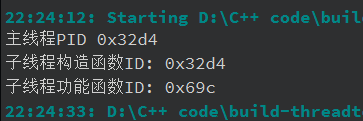Qt多线程有两种方法:
1、定义一个QThread的派生类,重写run函数,run函数中的程序就是新线程中要执行的内容。在主线程中实例化该类,调用start函数,就可以实现多线程。
2、定义一个QObject的派生类,把要在新线程中执行的内容写在一个槽函数中,然后把该派生类的对象传给QThread对象的moveToThread函数,用一个信号和槽函数绑定,当信号触发时,槽函数中的内容就会在子线程执行。
第一种方法
首先定义一个QThread的派生类
#ifndef MTHREAD_H
#define MTHREAD_H
#include<QThread>
#include<QDebug>
class MThread : public QThread
{
Q_OBJECT
public:
MThread();
void run() override;
};
#endif // MTHREAD_H
重写run函数,把子线程要执行的内容写到run函数中
#include "mthread.h"
MThread::MThread()
{
qDebug()<<"子线程构造函数PID:"<<QThread::currentThreadId();
}
void MThread::run()
{
qDebug()<<"子线程PID:"<<QThread::currentThreadId();
}
把上面定义的类加到Widget类中
#ifndef WIDGET_H
#define WIDGET_H
#include <QWidget>
#include"mthread.h"
class Widget : public QWidget
{
Q_OBJECT
public:
Widget(QWidget *parent = nullptr);
~Widget();
private:
MThread * thread;
};
#endif // WIDGET_H
在主线程中实例化上面定义的类,然后调用start函数,启动子线程。
#include "widget.h"
Widget::Widget(QWidget *parent)
: QWidget(parent),thread(new MThread)
{
qDebug()<<"主线程PID:"<<QThread::currentThreadId();
thread->start();
}
Widget::~Widget()
{
}
编译运行可以看到,MThread在主线程中实例化,然后run函数的内容在子线程运行。

第二种方法
先定义一个QObject的派生类,并定义一个threadfun函数(子线程要执行的内容就写在这个函数中)
#ifndef THREAD_H
#define THREAD_H
#include <QObject>
#include<QThread>
class Mthread : public QObject
{
Q_OBJECT
public:
explicit Mthread(QObject *parent = nullptr);
void threadfun();
};
#endif // THREAD_H
实现构造函数和子线程功能函数
#include "thread.h"
#include<QDebug>
Mthread::Mthread(QObject *parent) : QObject(parent)
{
qDebug()<<"子线程构造函数ID:"<<QThread::currentThreadId();
}
void Mthread::threadfun()
{
qDebug()<<"子线程功能函数ID:"<<QThread::currentThreadId();
}
把刚刚定义的类添加到widget中,并定义一个信号。
#ifndef WIDGET_H
#define WIDGET_H
#include <QWidget>
#include<QThread>
#include"thread.h"
class Widget : public QWidget
{
Q_OBJECT
public:
Widget(QWidget *parent = nullptr);
~Widget();
signals:
void tothread();
private:
QThread *thread_test;
Mthread *thread_class;
QThread *thread_another;
};
#endif // WIDGET_H
先实例化我们定义的Mthread类,然后定义一个Qt自带的QThread类,把信号和子线程功能函数connect在一起。然后把实例化的Mthread作为参数传给QThread的moveToThread函数,再调用start函数。当触发信号后,子线程功能函数就会在子线程执行。
#include "widget.h"
Widget::Widget(QWidget *parent)
: QWidget(parent)
{
thread_test=new QThread();
thread_class=new Mthread();
thread_another=new QThread();
connect(this,&Widget::tothread,thread_class,&Mthread::threadfun);
thread_class->moveToThread(thread_test);
thread_test->start();
emit tothread();
}
Widget::~Widget()
{
}

多说一嘴,Qt对控件的刷新操作只能是在主线程中,在子线程操作控件时,程序会直接死掉。
版权声明:本文为qq292263211原创文章,遵循 CC 4.0 BY-SA 版权协议,转载请附上原文出处链接和本声明。